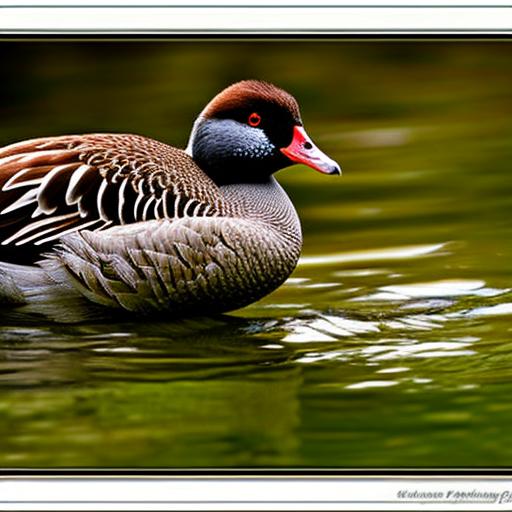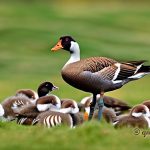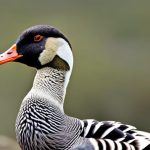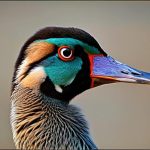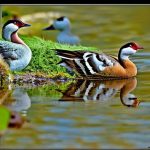Geese are known for their strong breeding instincts and complex social behaviors. Breeding season for geese typically occurs in the spring, when they begin to exhibit specific mating behaviors. During this time, geese become more territorial and aggressive, as they compete for mates and nesting sites. Understanding the breeding behavior of geese is essential for conservation efforts and for those who wish to breed geese in captivity.
Geese are monogamous birds, meaning they form long-term pair bonds with a single mate. These pair bonds are often formed during the previous breeding season and are reinforced through courtship displays and mating rituals. Geese are also highly territorial during the breeding season, aggressively defending their nesting sites from other geese and potential predators. Understanding the breeding behavior of geese can help researchers and conservationists develop strategies to protect nesting sites and ensure the survival of goslings.
Nesting and Egg-laying Habits
Geese are known for their elaborate nesting habits, which often involve building large, well-camouflaged nests in secluded areas near water. Female geese are responsible for selecting the nesting site and constructing the nest, using a combination of grasses, twigs, and down feathers to create a comfortable and secure environment for their eggs. Once the nest is complete, the female will lay a clutch of eggs, typically ranging from 4 to 8 eggs, depending on the species.
The female goose will then begin the process of incubating the eggs, rarely leaving the nest except to feed and drink. The male goose will stand guard nearby, keeping a watchful eye out for potential threats. The nesting period can last anywhere from 25 to 30 days, during which time the female will diligently tend to her eggs, ensuring they remain warm and protected. Understanding the nesting and egg-laying habits of geese is crucial for conservation efforts, as it allows researchers to identify and protect important nesting sites.
Courtship and Pair Bonding
Courtship and pair bonding are integral parts of the breeding behavior of geese. During the courtship phase, male geese will engage in elaborate displays to attract a mate. These displays often involve vocalizations, head bobbing, and wing flapping, as well as aggressive posturing towards other males. Once a pair bond is formed, male and female geese will engage in mutual preening and other bonding behaviors to strengthen their relationship.
Pair bonding in geese is typically long-lasting, with many pairs remaining together for multiple breeding seasons. This strong bond is essential for successful reproduction, as both male and female geese play important roles in protecting the nest and caring for their young. Understanding the courtship and pair bonding behaviors of geese can provide valuable insights into their social structure and reproductive success, helping researchers develop effective conservation strategies.
Incubation and Hatching Process
After the female goose has laid her clutch of eggs, she will begin the process of incubating them to ensure their survival. Incubation typically lasts around 25 to 30 days, during which time the female will rarely leave the nest except to feed and drink. The male goose will stand guard nearby, keeping watch for potential threats and predators.
As the incubation period nears its end, the eggs will begin to hatch, with the goslings using their egg tooth to break free from their shells. Once hatched, the goslings are precocial, meaning they are able to walk, swim, and feed themselves shortly after birth. The parents will lead their goslings to water shortly after hatching, where they will learn essential survival skills such as foraging for food and avoiding predators. Understanding the incubation and hatching process of geese is crucial for conservation efforts, as it allows researchers to monitor nesting sites and ensure the survival of goslings.
Parental Care and Protection
Once the goslings have hatched, both male and female geese play important roles in caring for and protecting their young. The parents will lead their goslings to water shortly after hatching, where they will teach them essential survival skills such as foraging for food and avoiding predators. The parents will also provide protection from potential threats, using their size and aggression to ward off predators such as foxes, raccoons, and other birds.
Parental care continues throughout the early stages of the goslings’ development, with both male and female geese taking turns watching over their young while the other feeds or rests. This cooperative parenting behavior is essential for the survival of the goslings, as it allows them to learn important skills while remaining protected from potential threats. Understanding parental care and protection behaviors of geese is crucial for conservation efforts, as it allows researchers to identify potential threats to goslings and develop strategies to mitigate them.
Challenges and Threats to Breeding Geese
Despite their strong breeding instincts and complex social behaviors, geese face numerous challenges and threats during the breeding season. Habitat loss and degradation are major threats to breeding geese, as they rely on specific nesting sites near water that are becoming increasingly scarce due to human development. Predation is also a significant threat to breeding geese, with predators such as foxes, raccoons, and other birds preying on eggs and goslings.
Human disturbance is another major threat to breeding geese, as increased human activity near nesting sites can disrupt breeding behaviors and cause stress to nesting pairs. Climate change is also impacting breeding geese, with changing weather patterns affecting food availability and nesting site suitability. Understanding the challenges and threats facing breeding geese is essential for conservation efforts, as it allows researchers to develop strategies to mitigate these threats and ensure the survival of breeding pairs and their young.
Conservation Efforts and Future Research Opportunities
Conservation efforts for breeding geese focus on protecting important nesting sites, mitigating threats from predators and human disturbance, and addressing habitat loss and degradation. This often involves working with landowners and local communities to implement conservation measures that benefit both geese and people. Future research opportunities for breeding geese include studying the impacts of climate change on nesting site suitability, developing innovative strategies for predator management, and identifying new nesting sites through habitat restoration efforts.
By understanding the breeding behavior of geese and addressing the challenges they face during the breeding season, researchers can develop effective conservation strategies that ensure the survival of breeding pairs and their young. Through ongoing research and conservation efforts, we can work towards a future where breeding geese thrive in healthy habitats across their range.
Meet Walter, the feathered-friend fanatic of Florida! Nestled in the sunshine state, Walter struts through life with his feathered companions, clucking his way to happiness. With a coop that’s fancier than a five-star hotel, he’s the Don Juan of the chicken world. When he’s not teaching his hens to do the cha-cha, you’ll find him in a heated debate with his prized rooster, Sir Clucks-a-Lot. Walter’s poultry passion is no yolk; he’s the sunny-side-up guy you never knew you needed in your flock of friends!

